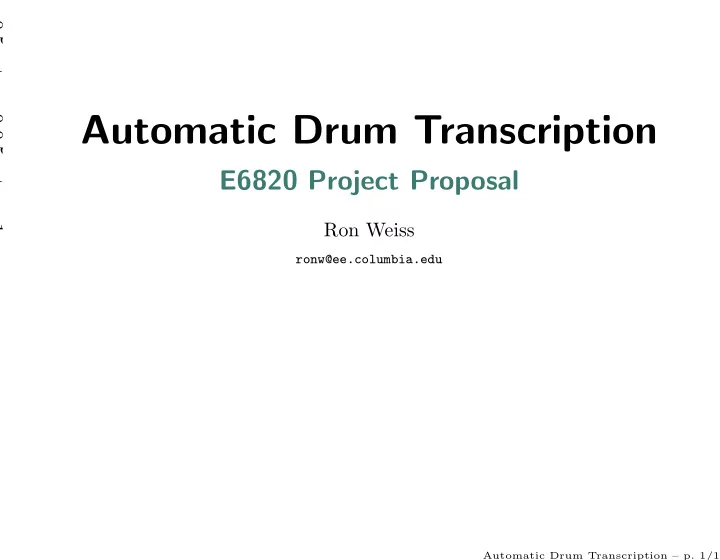

0.5 setgray0 0.5 setgray1 Automatic Drum Transcription E6820 Project Proposal Ron Weiss ronw@ee.columbia.edu Automatic Drum Transcription – p. 1/10
Motivation • What • Detect drum events in polyphonic music signal and assign class label • Why • Characterize rhythm of particular piece of music • Classify/search based on rhythmic similarity • Genre classification? Automatic Drum Transcription – p. 2/10
Challenges • Drums masked by other instruments • Need to detect simultaneous drum events • How to characterize different drum sounds? snare/bass 40 35 30 25 Frequency |bd |sd bd |bd |sd |bd 20 15 10 5 0 25 30 35 40 45 Time • Bass/snare drum can be characterized by narrowband spectral peaks at onset • Hi-hat/cymbals pretty much noise Automatic Drum Transcription – p. 3/10
Challenges 10000 8000 Frequency 6000 4000 2000 0 0 0.5 1 1.5 2 2.5 3 3.5 Time bd/hh bd/hh hh hh bd/hh hh bd sd sd sd bd/hh bd/hh hh hh bd/hh 10000 8000 6000 4000 2000 0 0 0.5 1 1.5 2 2.5 3 3.5 How to deal with interference from other instruments? Automatic Drum Transcription – p. 4/10
Previous Work • Template matching • Begin with seed template sound for each drum class • Detect onset times in signal - finds both note attacks and percussion events • Median filter to adapt template to actual drum sounds in music • Search narrowband STFT at each onset for matches with STFT of template. Compare top few spectral peaks with those of template - mostly ignores other instruments • Won’t work for noisy drums (hi-hat), works well for bass, snare • Template sometimes adapts to non drum sound (e.g. bass guitar note) • I already have a working version (sound) Automatic Drum Transcription – p. 5/10
Previous Work • Sinusoidal modeling • Remove sustained notes using sin+noise model. Noise residual contains drums and attack transients (sound) • Extract features corresponding to general shape of spectrum at each onset • Match general shape of spectrum at each onset • But spectral peaks are removed too... Automatic Drum Transcription – p. 6/10
Preliminary Results • 30 second clip of synthesized MIDI • Sin+noise model, detect onsets in residual signal • MFCCs of 100ms window around each onset Automatic Drum Transcription – p. 7/10
Preliminary Results bass snare closed hi−hat open hi−hat 1 0.5 0 3rd MFCC −0.5 −1 −12 −13 −1.5 −14 3 −15 2 −16 1 −17 0 −18 −1 1st MFCC −19 −2 2nd MFCC • First 3 MFCCs show promise for clustering snare drums • Hi-hats almost always occur with other drums • Spectral peaks probably needed to better detect bass drum Automatic Drum Transcription – p. 8/10
Goals • Combine the two methods to transcribe bass drum, snare drum, hi-hats. • Use features from both domains since some drum sounds are better characterized by the general shape of spectrum vs. narrowband spectral peaks. • Machine learning to discriminate between drum classes • Need to investigate features that are good at discriminators • Train on audio synthesized from MIDI - ground truth labels Automatic Drum Transcription – p. 9/10
References [1] K. Yoshii, M. Goto, and H. Okuno. Drum sound description for real-world music using template adaptation and matching methods. In Proceedings of ISMIR , 2004. [2] J. Sillanpaa, A. Klapuri, J. Seppanen, and T. Virtanen. Recognition of acoustic noise mixtures by combined bottom-up and top-down processing. In Proceedings of European Signal Processing Conference , 2000. [3] A. Zils, F. Pachet, O. Delerue, and F. Gouyon. Automatic extraction of drum tracks from polyphonic music signals. In Proceedings of WEDELMUSIC , December 2002. [4] P. Herrera, A. Yeterian, and F. Gouyon. Automatic classification of drum sounds: a comparison of feature selection methods and classification techniques. In Proceedings of the 2nd International Conference on Music and Artificial Intelligence , 2002. [5] M. Gruhne, C. Uhle, C. Dittmar, and M. Cremer. Extraction of drum patterns and their description within the MPEG-7 high-level-framework. In Proceedings of ISMIR , 2004. Automatic Drum Transcription – p. 10/10
Recommend
More recommend